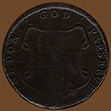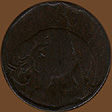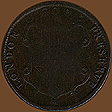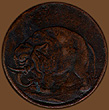Elephant Tokens - 1694
obverse |
|
reverse |
| |||
undated Hodder 2-B London Elephant Token
Obverse: [no text]
Reverse: : GOD : PRESERVE : [six poined star] : LONDON :
Weight: 244.9 g (15.87 grams) Diameter: 28.6 mm
Comments: The obverse has the elephant with the tusks near the rim. There are some planchet voids within the elephant and at the rim. The reverse shows the correct shield of London with the sword in the upper left quadrant. The center is worn so the cross is not readily apparent. This is the more common thick planchet variety. In fact, Breen gives the standard thick planchet weight at 233.3 grains which makes this worn 244.9 grain example rather heavy.
Provenance: From the Robert H. Gore, Jr. Numismatic Collection.
obverse |
|
reverse |
| |||
undated Hodder 2-B London Elephant Token
Obverse: [no text]
Reverse: : GOD : PRESERVE : [six poined star] : LONDON :
Weight: 225.8 g (14.63 grams) Diameter: 28.8 mm
Comments: The obverse has the elephant with the tusks almost to the beaded edge. There are some planchet voids within the elephant and a major planchet crack from the top of the coin down through the back leg of the elephant. The reverse shows the correct shield of London with the sword in the upper left quadrant although on this example the sword is quite worn and is not easily distinguished on the scanned image. The center is also quite worn so the cross is not readily apparent. This is the more common thick planchet variety.
Provenance: From the Robert H. Gore, Jr. Numismatic Collection.
obverse |
|
reverse |
| |||
1694 Electrotype of Hodder 2-F Carolina Elephant Token
Obverse: [no text]
Reverse: GOD : / PRESERVE : / CAROLINA : AND / THE : LORDS : / PROPRIETORS · / 1694
Weight: 217.1 g (14.06 grams) Diameter: 27.0 mm
Comments: R. Neil Fulghum, Keeper of the North Carolina Collection in the University of North Carolina at Chapel Hill informed me in a letter of May 11, 2001 that this coin is a electrotype. There is a copy in the North Carolina Collection at Chapel Hill and several others in the Smithsonian. He listed several diagnostics or consistent flaws in these electrotypes. Prominent features from the reverse include a small group of parallel lines found to the right of the 4 in the date near the rim, an X "die" crack near the rim below the 6 in the date and a small tick to the right at the top of the 1. There are several other diagnostics including a short crack near the rim above the O in GOD. Further, the diameter of both the North Carolina and the Notre Dame examples is 26mm. Also, the examples are rather thick, the weight of the Notre Dame example is far heavier than the weight of originals as cited by Breen.
The obverse shows the elephant with the tusks almost to the rim. There is a planchet void at the elephant's front feet. The reverse was copied slightly off center so that the beaded rim is consistently quite prominent in the lower portion the coin.
This is an electrotype of the second or corrected version in which the misspelling on PROPRIETERS was corrected to PROPRIETORS. The outline of the E can be seen within the final recut O. As is common on this issue the first S in PRESERVE is weak as well as the ND in AND. According to Breen originals of this variety were struck on planchets of three different weights called the: thick planchet (only one example cited with an observed weight of 176 grains), medium planchet (151-162 grains) and thin planchet (108-130 grains) varieties.
Some changes in the above description were suggested by Neil Fulghum. In an e-mail he included a useful distinction that most numismatists know but frequently do not use accurately. Namely, Neil reminded me, "electrotypes are not struck or stamped, so any imperfections on an electrotype should not be described as "die cracks" or irregularities. While an electrotype may be mirroring or copying actual die characteristics on its master or model, the term die should not be applied to the electrotype itself. Any consistent imperfections on the electrotype should be simply described as pattern flaws or duplicated irregularities." (E-mail of June 11, 2001) Thus, in the description above the term die has been used in quotes.
Provenance: From the Robert H. Gore, Jr. Numismatic Collection.
| New Yorke in America Token | Section Contents | Rosa Americana Coppers |
|
For viewing tips and information on optimal computer settings click
here.
For questions or comments contact Special Collections by: |





